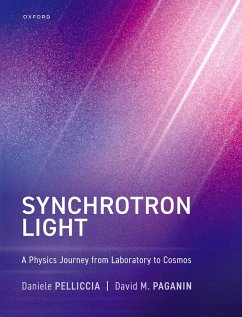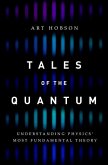- Gebundenes Buch
- Merkliste
- Auf die Merkliste
- Bewerten Bewerten
- Teilen
- Produkt teilen
- Produkterinnerung
- Produkterinnerung
Aimed at undergraduate and graduate students in physical sciences and engineering, this book provides a broad introduction to the physics of synchrotron light. The book is multi-disciplinary, covering topics from electrodynamics to particle physics through to astrophysics.
Andere Kunden interessierten sich auch für
![Tales of the Quantum Tales of the Quantum]() Art HobsonTales of the Quantum52,99 €
Art HobsonTales of the Quantum52,99 €![From Random Walks to Random Matrices From Random Walks to Random Matrices]() Jean Zinn-JustinFrom Random Walks to Random Matrices104,99 €
Jean Zinn-JustinFrom Random Walks to Random Matrices104,99 €![Topological Aspects of Condensed Matter Physics Topological Aspects of Condensed Matter Physics]() Topological Aspects of Condensed Matter Physics90,99 €
Topological Aspects of Condensed Matter Physics90,99 €![The Historical and Physical Foundations of Quantum Mechanics The Historical and Physical Foundations of Quantum Mechanics]() Robert GolubThe Historical and Physical Foundations of Quantum Mechanics171,99 €
Robert GolubThe Historical and Physical Foundations of Quantum Mechanics171,99 €![Quantum Gravity Quantum Gravity]() Claus KieferQuantum Gravity153,99 €
Claus KieferQuantum Gravity153,99 €![Quantum 20/20 Quantum 20/20]() Ian R KenyonQuantum 20/20108,99 €
Ian R KenyonQuantum 20/20108,99 €![Hyperspace Hyperspace]() Michio KakuHyperspace87,99 €
Michio KakuHyperspace87,99 €-
-
-
Aimed at undergraduate and graduate students in physical sciences and engineering, this book provides a broad introduction to the physics of synchrotron light. The book is multi-disciplinary, covering topics from electrodynamics to particle physics through to astrophysics.
Produktdetails
- Produktdetails
- Verlag: Oxford University Press
- Seitenzahl: 736
- Erscheinungstermin: 25. November 2025
- Englisch
- Abmessung: 145mm x 196mm x 43mm
- Gewicht: 1724g
- ISBN-13: 9780192846273
- ISBN-10: 0192846272
- Artikelnr.: 73852171
- Herstellerkennzeichnung
- Libri GmbH
- Europaallee 1
- 36244 Bad Hersfeld
- gpsr@libri.de
- Verlag: Oxford University Press
- Seitenzahl: 736
- Erscheinungstermin: 25. November 2025
- Englisch
- Abmessung: 145mm x 196mm x 43mm
- Gewicht: 1724g
- ISBN-13: 9780192846273
- ISBN-10: 0192846272
- Artikelnr.: 73852171
- Herstellerkennzeichnung
- Libri GmbH
- Europaallee 1
- 36244 Bad Hersfeld
- gpsr@libri.de
Daniele Pelliccia is an experimental physicist and entrepreneur. He graduated with a master's degree in quantum optics and quantum information, and undertook his PhD research in x-ray optics and imaging. Daniele has been a staff scientist at synchrotron beamlines in Germany and Australia. During his academic career Daniele has secured a DECRA fellowship (Australia) for the development of novel x-ray microscopy techniques. Since 2017, Daniele has been a full-time entrepreneur, founding the company Instruments & Data Tools providing modelling and analytics services for industry. In 2018 Daniele founded Rubens Technologies, commercialising portable spectroscopy sensors for fruit quality assessment. David M. Paganin is a theoretical physicist with a range of research interests in optical physics. He graduated with a PhD in 1999. David has been affiliated with Monash University since 2002, first as a lecturer and more recently as an adjunct researcher with the School of Physics and Astronomy. He is the author of Coherent X-ray Optics (OUP 2006) and co-invented several techniques in coherent imaging that are currently widely employed in the fields of x-ray synchrotron science, visible-light microscopy, and electron microscopy.
1: Prologue
2: Introduction to special relativity
3: Emission from accelerated charges
4: Radiation emitted by charges in bending magnets
5: Insertion devices
6: Quantum effects in synchrotron radiation
7: Quantum effects in relativistic charged-particle orbits
8: The free-electron laser
9: Synchrotron light in the cosmos
10: Non-photon analogues of synchrotron radiation
11: Calculation of synchrotron radiation from first principles
12: Quantum optics of synchrotron light
13: Epilogue
Appendix A - Bessel-function sums and trigonometric integrals
Appendix B - Planck's radiation law and radiometric quantities
Appendix C - Schott's pioneering contributions to synchrotron light
Appendix D - Padé approximant for maximum-emission harmonic
2: Introduction to special relativity
3: Emission from accelerated charges
4: Radiation emitted by charges in bending magnets
5: Insertion devices
6: Quantum effects in synchrotron radiation
7: Quantum effects in relativistic charged-particle orbits
8: The free-electron laser
9: Synchrotron light in the cosmos
10: Non-photon analogues of synchrotron radiation
11: Calculation of synchrotron radiation from first principles
12: Quantum optics of synchrotron light
13: Epilogue
Appendix A - Bessel-function sums and trigonometric integrals
Appendix B - Planck's radiation law and radiometric quantities
Appendix C - Schott's pioneering contributions to synchrotron light
Appendix D - Padé approximant for maximum-emission harmonic
1: Prologue
2: Introduction to special relativity
3: Emission from accelerated charges
4: Radiation emitted by charges in bending magnets
5: Insertion devices
6: Quantum effects in synchrotron radiation
7: Quantum effects in relativistic charged-particle orbits
8: The free-electron laser
9: Synchrotron light in the cosmos
10: Non-photon analogues of synchrotron radiation
11: Calculation of synchrotron radiation from first principles
12: Quantum optics of synchrotron light
13: Epilogue
Appendix A - Bessel-function sums and trigonometric integrals
Appendix B - Planck's radiation law and radiometric quantities
Appendix C - Schott's pioneering contributions to synchrotron light
Appendix D - Padé approximant for maximum-emission harmonic
2: Introduction to special relativity
3: Emission from accelerated charges
4: Radiation emitted by charges in bending magnets
5: Insertion devices
6: Quantum effects in synchrotron radiation
7: Quantum effects in relativistic charged-particle orbits
8: The free-electron laser
9: Synchrotron light in the cosmos
10: Non-photon analogues of synchrotron radiation
11: Calculation of synchrotron radiation from first principles
12: Quantum optics of synchrotron light
13: Epilogue
Appendix A - Bessel-function sums and trigonometric integrals
Appendix B - Planck's radiation law and radiometric quantities
Appendix C - Schott's pioneering contributions to synchrotron light
Appendix D - Padé approximant for maximum-emission harmonic








